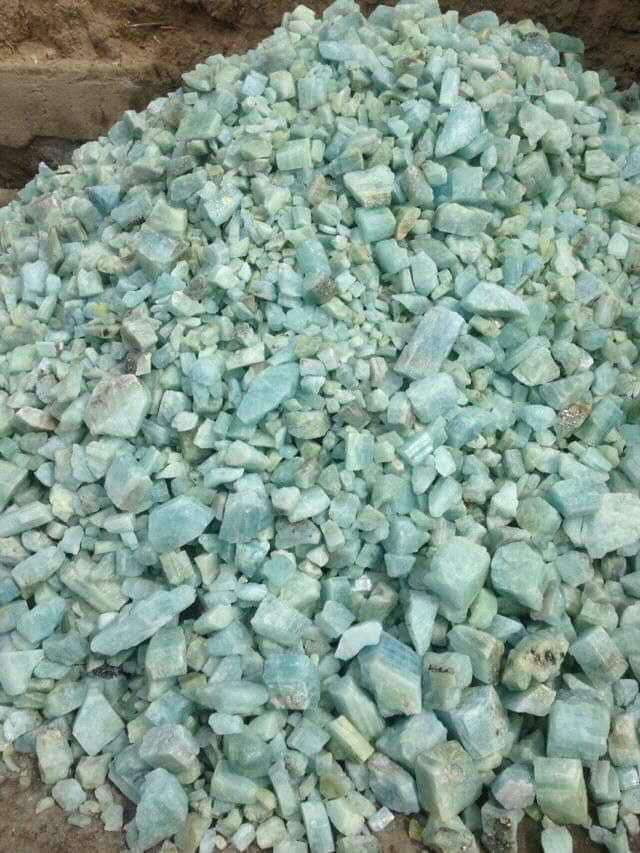Beryllium Ore: An In-Depth Analysis
Introduction
Beryllium is a rare element known for its remarkable properties such as high stiffness, lightweight, and excellent thermal conductivity. Its applications span various industries including aerospace, defense, telecommunications, and medical devices. This article delves into the nature of beryllium ore, its extraction, processing, and applications, as well as the associated economic and environmental considerations.

Geology and Types of Beryllium Ore
Beryllium is primarily found in two types of minerals: beryl (Be₃Al₂(SiO₃)₆) and bertrandite (Be₄Si₂O₇(OH)₂).
- Beryl:
- Composition: Beryl is a beryllium aluminium cyclosilicate.
- Occurrence: Beryl is commonly found in pegmatite veins and granitic rocks. Gem-quality beryl varieties include emerald and aquamarine.
- Distribution: Major deposits are located in Brazil, Colombia, Russia, and the United States.
- Bertrandite:
- Composition: Bertrandite is a beryllium silicate hydroxide mineral.
- Occurrence: Bertrandite is typically found in hydrothermal veins associated with volcanic rocks.
- Distribution: The largest deposits are in the Spor Mountain area in Utah, USA.
Physical and Chemical Properties of Beryllium Ore
Physical Properties
- Color:
- Beryl: Typically green, blue, yellow, or colorless; gem varieties like emerald are deep green.
- Bertrandite: Usually colorless to pale yellow.
- Crystal System:
- Beryl: Hexagonal system.
- Bertrandite: Orthorhombic system.
- Hardness:
- Beryl: 7.5-8 on the Mohs scale.
- Bertrandite: 6-7 on the Mohs scale.
- Luster:
- Beryl: Vitreous (glass-like).
- Bertrandite: Vitreous to pearly.
- Cleavage:
- Beryl: Poor to indistinct cleavage.
- Bertrandite: Perfect cleavage in one direction.
- Fracture:
- Beryl: Conchoidal (shell-like) to uneven.
- Bertrandite: Uneven to splintery.
- Density:
- Beryl: 2.63-2.92 g/cm³.
- Bertrandite: 2.59-2.60 g/cm³.
- Transparency:
- Beryl: Transparent to translucent.
- Bertrandite: Transparent to translucent.
Chemical Properties
- Chemical Composition:
- Beryl: Be₃Al₂(SiO₃)₆
- Beryllium: 5.03% by weight.
- Aluminum: 10.04% by weight.
- Silicon: 31.35% by weight.
- Oxygen: 53.58% by weight.
- Bertrandite: Be₄Si₂O₇(OH)₂
- Beryllium: 19.99% by weight.
- Silicon: 19.75% by weight.
- Oxygen: 54.18% by weight.
- Hydrogen: 1.07% by weight.
- Reactivity:
- Beryllium ores are relatively stable under standard conditions but can react with strong acids and bases during processing.
- Beryl:
- Insoluble in water.
- Dissolves slowly in hot hydrochloric acid.
- Bertrandite:
- Reacts with sulfuric acid to form beryllium sulfate.
- Thermal Properties:
- Beryllium ores have high melting points due to the strong bonds within the mineral structures.
- Beryl:
- Melting Point: Approximately 1,650°C.
- Bertrandite:
- Decomposes before melting, around 1,400°C.
- Electromagnetic Properties:
- Beryllium ores do not conduct electricity well due to their non-metallic nature.
- They are also generally non-magnetic.
Comparison of Physical and Chemical Properties
- Beryl vs. Bertrandite:
- Beryl tends to form larger and more robust crystals compared to bertrandite.
- Bertrandite has a higher beryllium content per weight unit but is less common than beryl.
- Industrial Implications:
- The different properties of beryl and bertrandite influence their processing methods. Beryl requires more energy-intensive processes due to its hardness and stability, while bertrandite is more chemically reactive, allowing for easier leaching.
Significance of Physical and Chemical Properties
- Extraction and Processing:
- Knowledge of the physical and chemical properties of beryllium ores is crucial for designing efficient extraction and processing methods.
- The hardness of beryl affects crushing and grinding operations, while the chemical reactivity of bertrandite influences leaching techniques.
- Application Suitability:
- The high strength and lightweight properties of beryllium make it ideal for aerospace and defense applications.
- Its transparency to X-rays and stability under high temperatures are vital for medical and electronic uses.
- Economic Value:
- The rarity and specialized properties of beryllium ores contribute to their high economic value.
- Efficient extraction and processing methods can significantly impact the cost and availability of beryllium.
Understanding the physical and chemical properties of beryllium ores like beryl and bertrandite is essential for their effective utilization in various high-tech applications, as well as for the development of safe and sustainable mining and processing practices.
How to identify beryllium ore?
Identifying beryllium ore involves recognizing its physical properties, testing its chemical composition, and sometimes using specialized equipment. Here’s a comprehensive guide on how to identify beryl and bertrandite, the primary beryllium-bearing minerals.
Identifying Beryl (Be₃Al₂(SiO₃)₆)
- Visual Inspection:
- Color: Beryl can be green, blue, yellow, white, or colorless. Gem varieties like emerald (green) and aquamarine (blue) are distinctive.
- Crystal Form: Beryl commonly forms hexagonal prismatic crystals that are often well-formed and large.
- Hardness Test:
- Beryl has a hardness of 7.5-8 on the Mohs scale. It can scratch glass and be scratched by harder materials like quartz or topaz.
- Luster:
- Beryl has a vitreous (glass-like) luster, making it shiny when light reflects off its surface.
- Transparency:
- Beryl can be transparent to translucent, depending on its quality and impurities.
- Cleavage and Fracture:
- Beryl has poor cleavage and typically shows conchoidal (shell-like) to uneven fracture patterns.
- Specific Gravity:
- Beryl has a specific gravity of 2.63-2.92, which can be measured using a heavy liquid separation method or a density kit.
- Streak Test:
- When scratched on a porcelain streak plate, beryl usually leaves a white streak.
Identifying Bertrandite (Be₄Si₂O₇(OH)₂)
- Visual Inspection:
- Color: Bertrandite is usually colorless to pale yellow.
- Crystal Form: Bertrandite typically forms small, orthorhombic crystals that may appear tabular or prismatic.
- Hardness Test:
- Bertrandite has a hardness of 6-7 on the Mohs scale, making it softer than beryl but still capable of scratching glass.
- Luster:
- Bertrandite has a vitreous to pearly luster, giving it a somewhat shiny appearance.
- Transparency:
- Bertrandite is generally transparent to translucent.
- Cleavage and Fracture:
- Bertrandite has perfect cleavage in one direction, making it more likely to break along flat planes.
- Specific Gravity:
- Bertrandite has a specific gravity of 2.59-2.60, which can be measured similarly to beryl.
- Streak Test:
- Bertrandite also typically leaves a white streak when scratched on a porcelain streak plate.
Advanced Identification Methods
- X-ray Diffraction (XRD):
- XRD can precisely identify minerals based on their crystal structure. Beryl and bertrandite have distinct XRD patterns.
- Electron Microprobe Analysis:
- This technique measures the chemical composition of minerals at a microscopic level, confirming the presence of beryllium.
- Spectroscopic Methods:
- Techniques like Raman spectroscopy and infrared spectroscopy can provide information on the molecular vibrations of minerals, helping in their identification.
- Flame Test:
- Although not commonly used for beryllium ores, a flame test can sometimes be used to identify elements based on the color of the flame. However, this method is more appropriate for elements like sodium and potassium.
Field Identification Tips
- Location:
- Knowing the geological context can help in identifying beryllium ores. Beryl is often found in pegmatites, while bertrandite is found in hydrothermal veins.
- Associated Minerals:
- Beryl is often associated with minerals like quartz, feldspar, and mica in pegmatites.
- Bertrandite can be found with fluorite, topaz, and other hydrothermal minerals.
- Geiger Counter:
- Some beryllium ores, especially those associated with uranium minerals, may show slight radioactivity. A Geiger counter can help detect this.
Safety Precautions
- Handling:
- Beryllium and its compounds can be toxic if inhaled or ingested. Always use protective equipment like gloves and masks when handling ore samples.
- Processing:
- Ensure proper ventilation and dust control measures when crushing or grinding beryllium ores to prevent inhalation of beryllium dust.
By combining visual inspection, physical tests, and advanced analytical methods, you can accurately identify beryllium ores in the field or laboratory. Always consider safety precautions due to the potential toxicity of beryllium.
Mining and Extraction of Beryllium Ore
The extraction of beryllium from its ores involves several stages:
- Mining:
- Open-pit Mining: This is the most common method for extracting beryllium ore. It involves removing large quantities of overburden to access the ore.
- Underground Mining: Less common but used when ore bodies are deep or not suitable for open-pit mining.
- Crushing and Milling:
- Primary Crushing: Large rocks containing beryllium ore are reduced to smaller pieces.
- Milling: The crushed ore is further ground to liberate the beryllium minerals from the surrounding material.
- Concentration:
- Flotation: This process separates beryllium minerals from the gangue using a froth flotation technique.
- Magnetic Separation: Occasionally used to concentrate beryllium ores, depending on their magnetic properties.
- Chemical Processing:
- Leaching: Beryllium is extracted from the concentrated ore using an acidic solution, typically sulfuric acid for bertrandite and sodium hydroxide for beryl.
- Precipitation: The beryllium is precipitated out of the leach solution by adjusting the pH or by adding other chemicals.
- Calcination: The precipitated beryllium compound is heated to high temperatures to produce beryllium hydroxide.
- Refinement:
- Electrolytic Reduction: Beryllium hydroxide is converted to beryllium fluoride or beryllium chloride, which are then reduced electrolytically to produce pure beryllium metal.

Applications of Beryllium
Beryllium’s unique properties make it invaluable in several high-tech applications:
- Aerospace and Defense:
- Structural Components: Used in aircraft, missiles, and spacecraft for its high strength-to-weight ratio.
- Mirrors and Optical Systems: Beryllium mirrors are used in satellites and telescopes due to their stability and light weight.
- Electronics and Telecommunications:
- Connectors and Contacts: Beryllium copper alloys are used in electronic connectors and contacts for their electrical conductivity and durability.
- Heat Sinks: Beryllium is used in heat sinks to dissipate heat in high-performance electronics.
- Medical Devices:
- X-ray Windows: Beryllium is transparent to X-rays and is used in X-ray equipment.
- Medical Lasers: Beryllium is used in certain types of medical lasers.
- Nuclear Industry:
- Moderator and Reflector: Beryllium is used in nuclear reactors as a neutron moderator and reflector.
Economic and Environmental Considerations
- Economic Aspects:
- Supply and Demand: The supply of beryllium is limited due to the rarity of beryllium ore, making it relatively expensive.
- Market Dynamics: The demand for beryllium is driven by its specialized applications, particularly in defense and aerospace.
- Environmental Impact:
- Mining and Processing: Beryllium mining and processing can have significant environmental impacts, including habitat destruction, water contamination, and air pollution.
- Health Hazards: Beryllium is toxic, and exposure can lead to a chronic lung disease called berylliosis. Proper safety measures and regulations are essential to protect workers and the environment.
- Sustainability and Recycling:
- Recycling: Beryllium is recyclable, and recycling efforts can reduce the need for new mining and mitigate environmental impacts.
- Regulations: Strict regulations govern the handling, processing, and disposal of beryllium to minimize health and environmental risks.
Conclusion
Beryllium ore is a critical resource with diverse and high-tech applications. The extraction and processing of beryllium require advanced techniques due to its rarity and the need for environmental and health safety measures. As technology advances, the demand for beryllium is likely to grow, underscoring the importance of sustainable practices in its extraction and use.